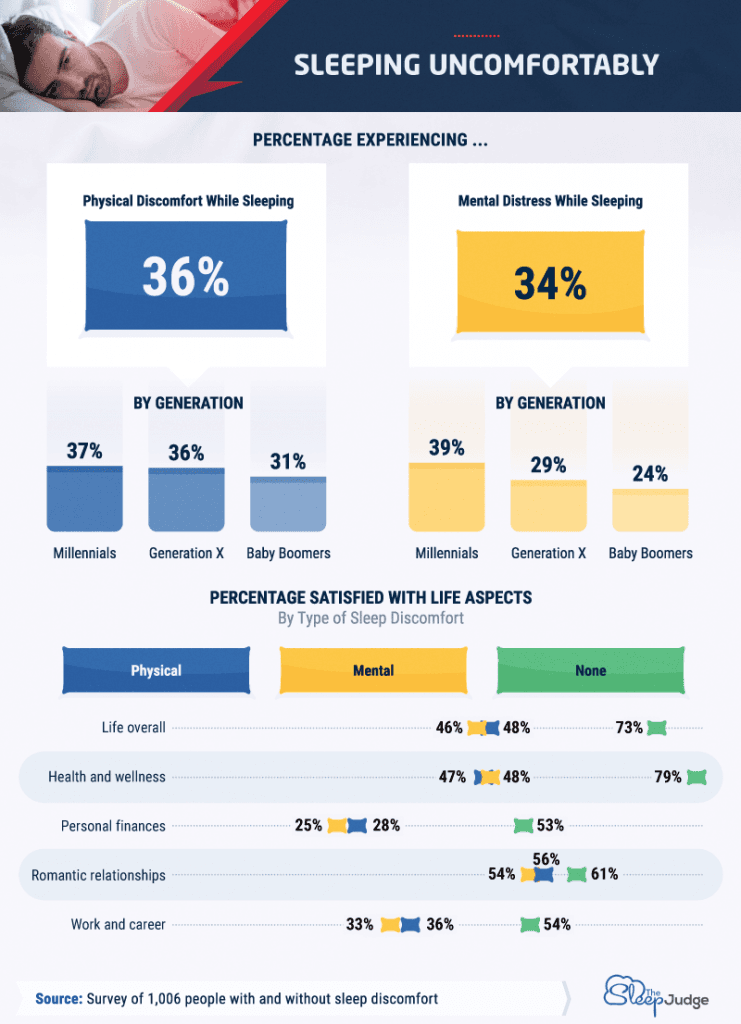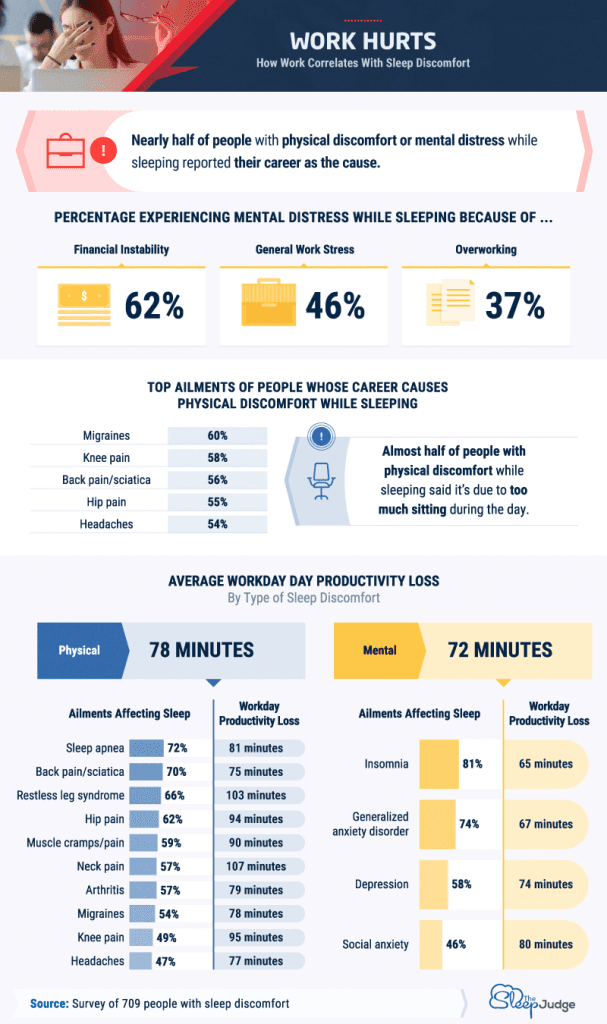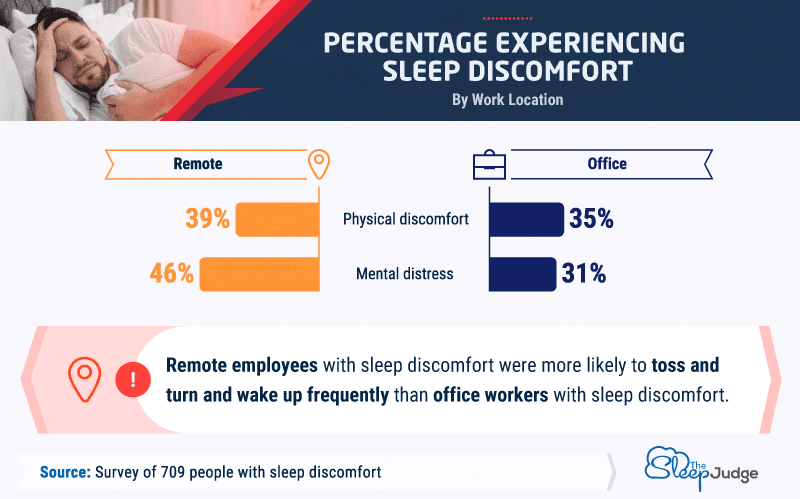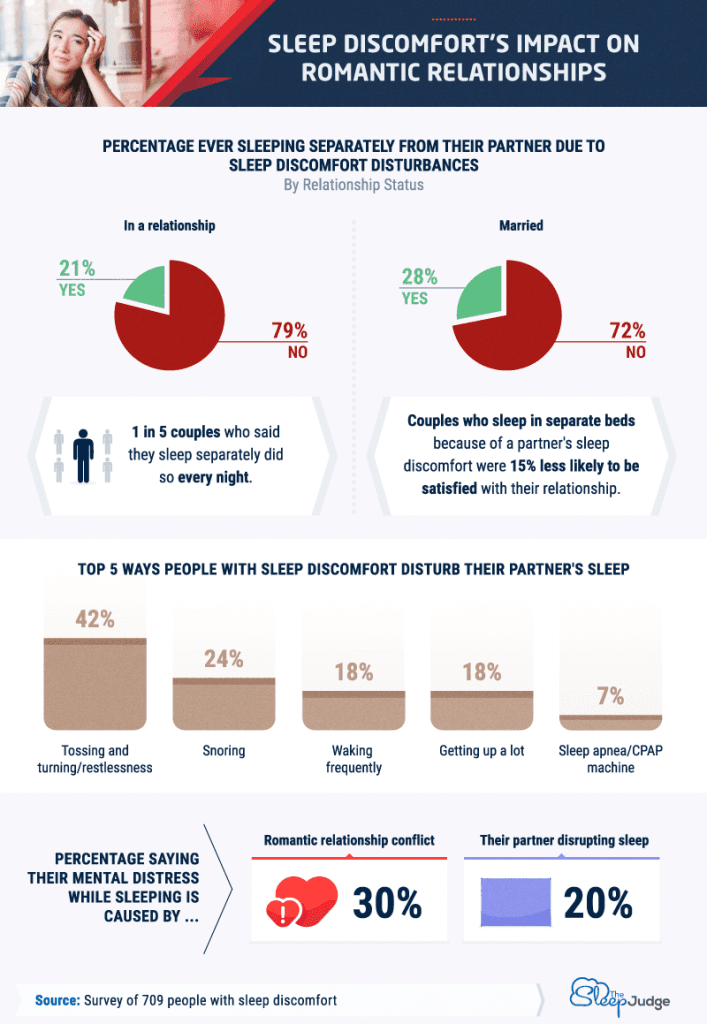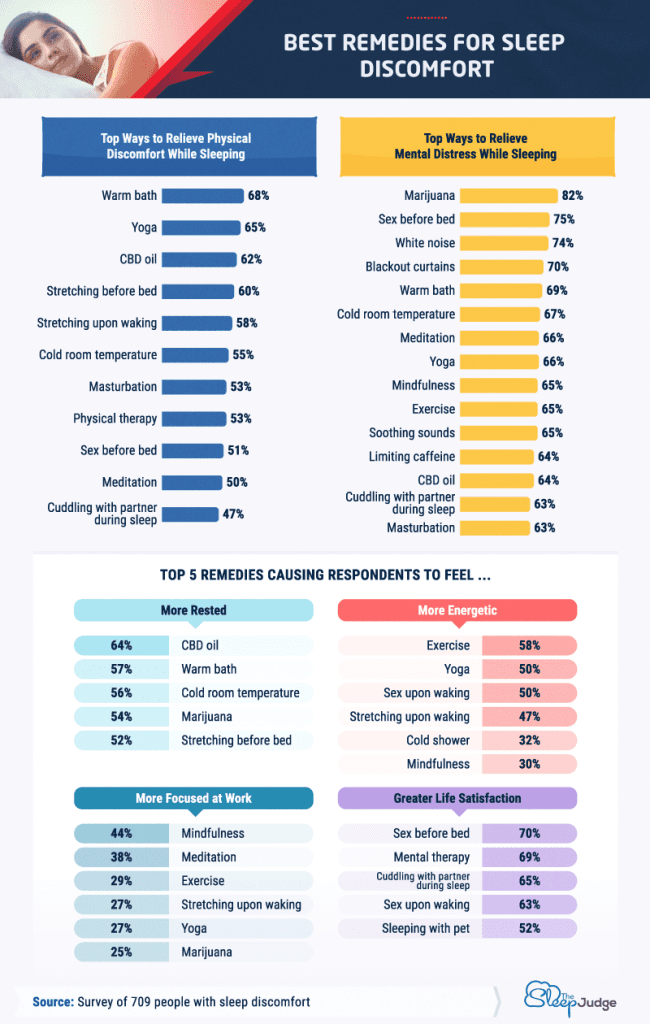For many of the estimated 6 in 10 U.S. adults who have a chronic illness, according to the Centers for Disease Control and Prevention (CDC), symptoms can obstruct otherwise organized aspects of someone’s life, including their routine, career, and sleep schedule. In fact, sticking to a schedule can be increasingly tough for people who deal with ongoing conditions, negatively affecting the quality of life for Americans who seek relief.
One of the largest pain points for people diagnosed with a chronic illness is diminished sleep health. Common physical ailments such as back injuries, herniated discs, and sciatica (among others) can result in excruciating pain and dramatically reduce someone’s chances of a restful night’s sleep. Additionally, mental stressors that come from work and relationships can prevent someone’s mind from winding down before bed.
To discover how sleep discomfort impacts the population, we surveyed over 1,000 people to learn how they deal with sleep problems related to their ailments. Keep reading to uncover the most effective ways our survey respondents relieve pain and manage their symptoms.
Physical, Mental Pains Prevent Proper Sleep
That staggering CDC figure paints a painful picture of America’s collective health today, and our study sought to add to our understanding of chronic illnesses. Significant percentages of our survey pool pointed to mental or physical issues as the culprit behind their sleep woes: 36% experienced physical discomfort, while 34% said mental stressors created sleep difficulties.
Unfortunately, sleep deprivation or difficulties can catalyze a multitude of other side effects and lead to an increased risk of accidents due to delayed response time and/or a lack of focus. Juggling mental or physical ailments and sleep loss can affect someone’s overall quality of life, as our survey participants with sleep discomfort indicated. While 73% of respondents without sleep discomfort were satisfied with life overall, less than half of people with sleep discomfort, whether physical or mental, were as optimistic with their outlook.
Luckily, having sleep discomfort doesn’t seem to have much of an impact on romantic relationships. It’s possible to enjoy relationships to their fullest by being honest about your health, especially if you have a chronic condition.
Sleep Struggles Fueled by Professional Stress
Money and career frustrations were major factors in survey respondents experiencing mental distress while sleeping: 62% with mental stressors while sleeping blamed financial instability, 46% pointed to general work stress, and 37% cited overworking as causing them harm. Millennials were the most likely generation to say their mental distress while sleeping was caused by their career (50%).
Headaches and migraines can be debilitating. Beyond taking medication, treating symptoms often involves finding an isolated, quiet, and dark place, which can be difficult in a traditional office environment with computer screens and social interaction. These issues, along with knee, hip, and back pain, accounted for a major portion of conditions that respondents experienced while sleeping.
Two conditions, in particular, restless leg syndrome (RLS) and neck pain, created the largest disruptions in work productivity, with the average employee losing over 100 minutes of his or her workday to managing symptoms and coping with sleep loss.
Habitual loss of sleep, known as insomnia, also affected the sleep of 81% of people, while general anxiety disorder, depression, and social anxiety led to sleep interruptions or delays, as well.
Sleep Discomfort: Remote vs. Office Workers
While remote work offers exceptional flexibility, we found that those employees were more likely to experience uncomfortable sleep: Remote workers were 4 percentage points more likely to deal with physical issues while sleeping and 15 percentage points more likely to experience mental distress than employees working in an office.
Research shows that it can be more difficult for remote workers to establish clear boundaries and a proper work-life balance, which can make it harder to disconnect when the workday ends. These employees don’t have to deal with bringing work home, but that’s only because the work is already at home. Mental health issues among remote workers continue to rise while they deal with the side effects.
Losing sleep means more than just health risks. Productivity can be held back due to focusing on treating and managing ailment symptoms. So working professionals must take a step back and evaluate how their careers affect their physical and mental health.
Look for Love, Find a Helping Hand
For people with physical or mental discomfort, some couples have found it necessary to sleep separately: 1 in 5 people who said they sleep separately did so every night. Further, 30% of people with generalized anxiety disorder and 29% of people with back pain slept separately from their partners due to their symptoms while sleeping.
Sleeping in the same bed as our significant other can release oxytocin, lower our blood pressure, and deepen our romantic connection, among other benefits. And sleep issues deprive couples of this experience during the night: Couples who didn’t sleep together were 15% less likely to feel satisfied with their relationship.
Managing sleep issues can be tough when you have a partner, as they may be affected by the late-night tossing and turning or snoring of their loved one. This sleep disruption means that well-intentioned couples have to sacrifice togetherness for sound sleep.
Top Solutions to Overcome Sleep Difficulties
Since everyone’s ailments and symptoms vary, our survey produced a wide range of remedies that participants relied on to get better sleep. Sixty-eight percent of people found that a warm bath effectively treated their physical discomfort while sleeping, while 82% had success with marijuana in relieving their mental distress.
Today, 33 states have passed medical allowances for marijuana, with 11 states, plus Washington, D.C., allowing recreational marijuana use. Marijuana and its properties have been hailed by patients and researchers for reducing pain, stimulating appetite, halting migraines, and positively impacting patients with neurological disorders, such as seizures.
Stretching and yoga also proved to be effective for the majority of respondents dealing with physical discomfort while sleeping, with 65% turning to yoga to curb bodily pain and 59% stretching in the morning or evening. Stretching is a low-impact activity that keeps the muscles strong and gives us the chance to focus on ourselves.
Sleep Loss, Ailments, and Management
Treatment for sleep discomfort does not follow a one-size-fits-all model, giving validity to even the most creative types of symptom management. Physical and mental pain can catalyze a wide variety of sleep issues and disorders, increasing the importance in controlling variables that can be kept steady, such as the time you go to bed and the methods and rituals used to wind down.
Dealing with sleep issues and ailments can be overwhelming, but it doesn’t have to be. Starting small, like making positive changes to your diet or establishing a consistent sleep schedule, can help you improve your quality of sleep. Another way to do this is by investing in a proper mattress. Visit The Sleep Judge and learn about the top mattresses and products designed to achieve optimal sleep health.
Methodology and Limitations
We used Amazon Mechanical Turk to survey a total of 1,006 respondents about their experiences with physical discomfort while sleeping, mental distress while sleeping, and lack of discomfort while sleeping. We created two surveys to collect respondents for our study: one for people who experienced physical discomfort and/or mental distress while sleeping (709 respondents) and one for those experiencing neither (297 respondents). To be included in our data, respondents were required to complete their respective survey and pass an attention-check question in the middle of each survey. Participants who failed to do either of these were excluded from the study.
Of all the respondents, 48% were women, 51% were men, and less than 1% reported a nonbinary gender. 51% of respondents were millennials (born 1981 to 1997); 34% were from Generation X (born 1965 to 1980); and 15% were baby boomers (born 1946 to 1964). Generation Z (born 1998 to 2017), the silent generation (born 1928 to 1945), and the greatest generation (born 1927 or earlier) were excluded from the study. The average age of respondents was 40 with a standard deviation of 12 years. The data had a 4% margin of error for millennials, a 5% margin of error for Generation X, and an 8% margin of error for baby boomers.
In finding averages of quantitative values, we removed outliers so that data were not exaggerated. Also, in visualizations of remedies, we did not include remedies with insufficient, and therefore misleading, sample sizes.
Fair Use Statement
Sound sleep can be hard to come by. Maybe someone you know is dealing with poor sleep, or this data directly relates to you. Share our findings far and wide, but please be sure to cite us by name when sharing this study and only share for noncommercial use.

